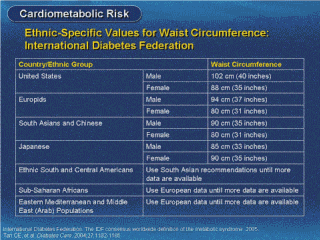| front |1 |2 |3 |4 |5 |6 |7 |8 |9 |10 |11 |12 |13 |14 |15 |16 |17 |18 |19 |20 |21 |22 |23 |24 |25 |26 |27 |28 |29 |30 |31 |32 |33 |34 |35 |36 |review |
 |
According to the International Diabetes
Foundation (IDF) definition of the metabolic syndrome, central obesity
(defined by waist circumference) is an essential component for diagnosis of
the syndrome. The IDF definition recognizes ethnic-specific values for waist
circumference, as shown on this slide. The IDF consensus group acknowledged
that these are pragmatic cut-points taken from various different data
sources, and that better data will be needed to link these to risk. The IDF points out that although a higher cut-point is currently used for all ethnic groups in the United States for clinical diagnosis, it is strongly recommended that for epidemiological studies and, wherever possible, for case detection, ethnic group-specific cut-points should be used for people of the same ethnic group wherever they are found. Thus the criteria recommended for Japan would also be used in expatriate Japanese communities, as would those for South Asian males and females regardless of place and country of residence. International Diabetes Federation. The IDF consensus worldwide definition of the metabolic syndrome. 2005. Tan CE, Ma S, Wai D, et al. Can we apply the National Cholesterol Education Program Adult Treatment Panel definition of the metabolic syndrome to Asians? Diabetes Care. 2004;27:1182-1186. |